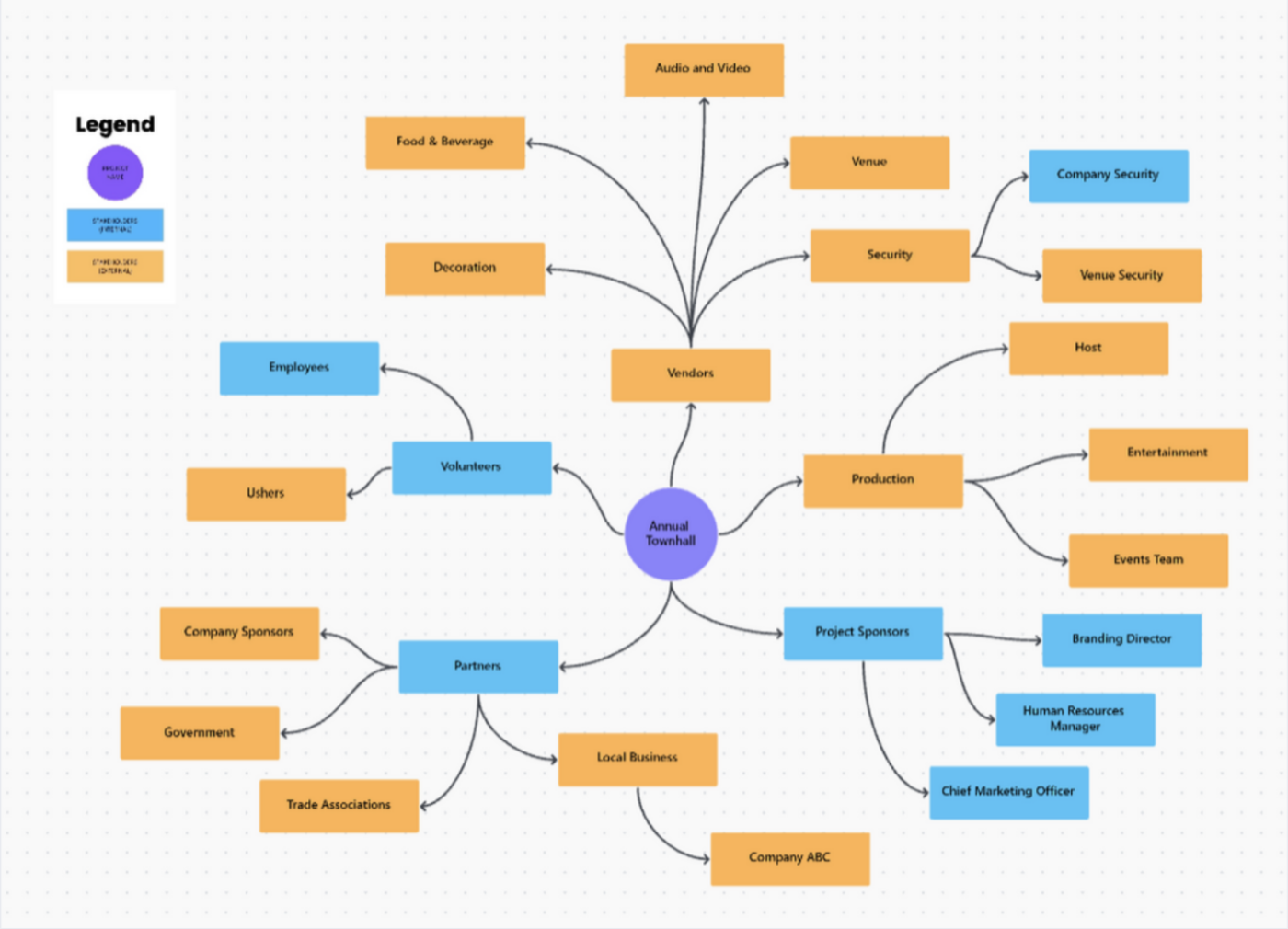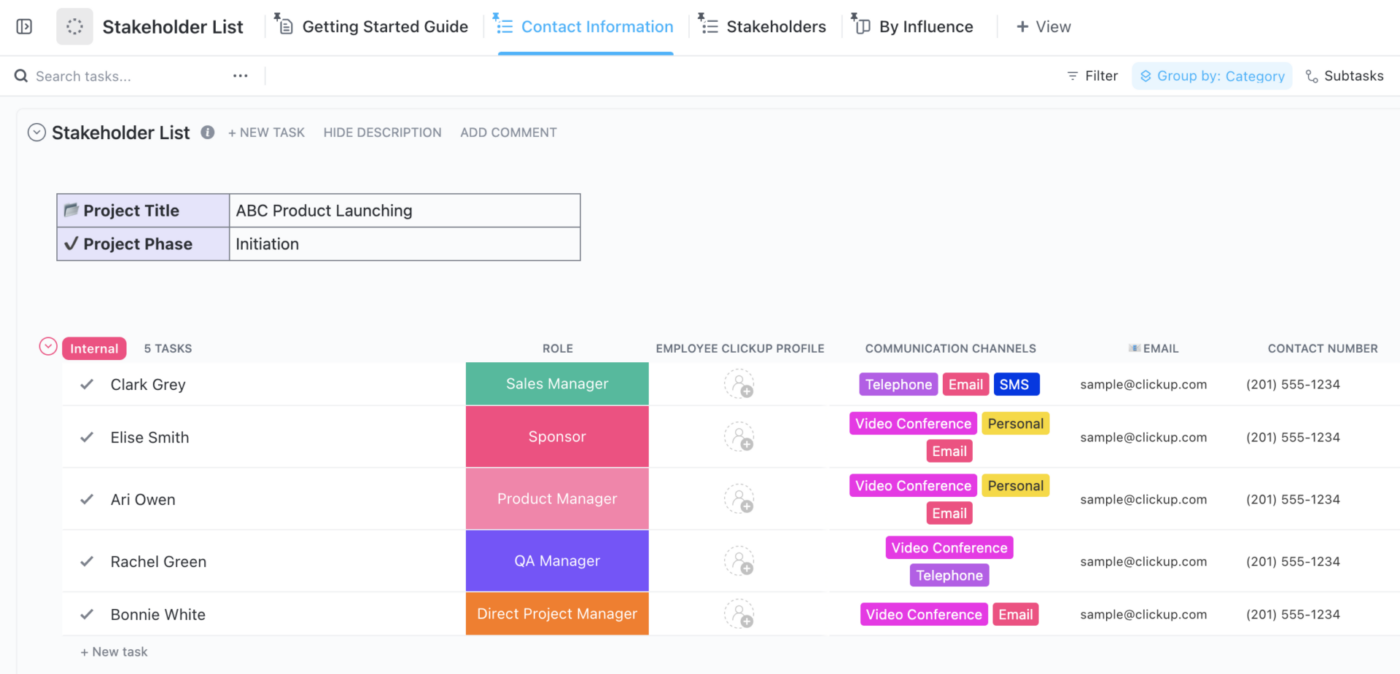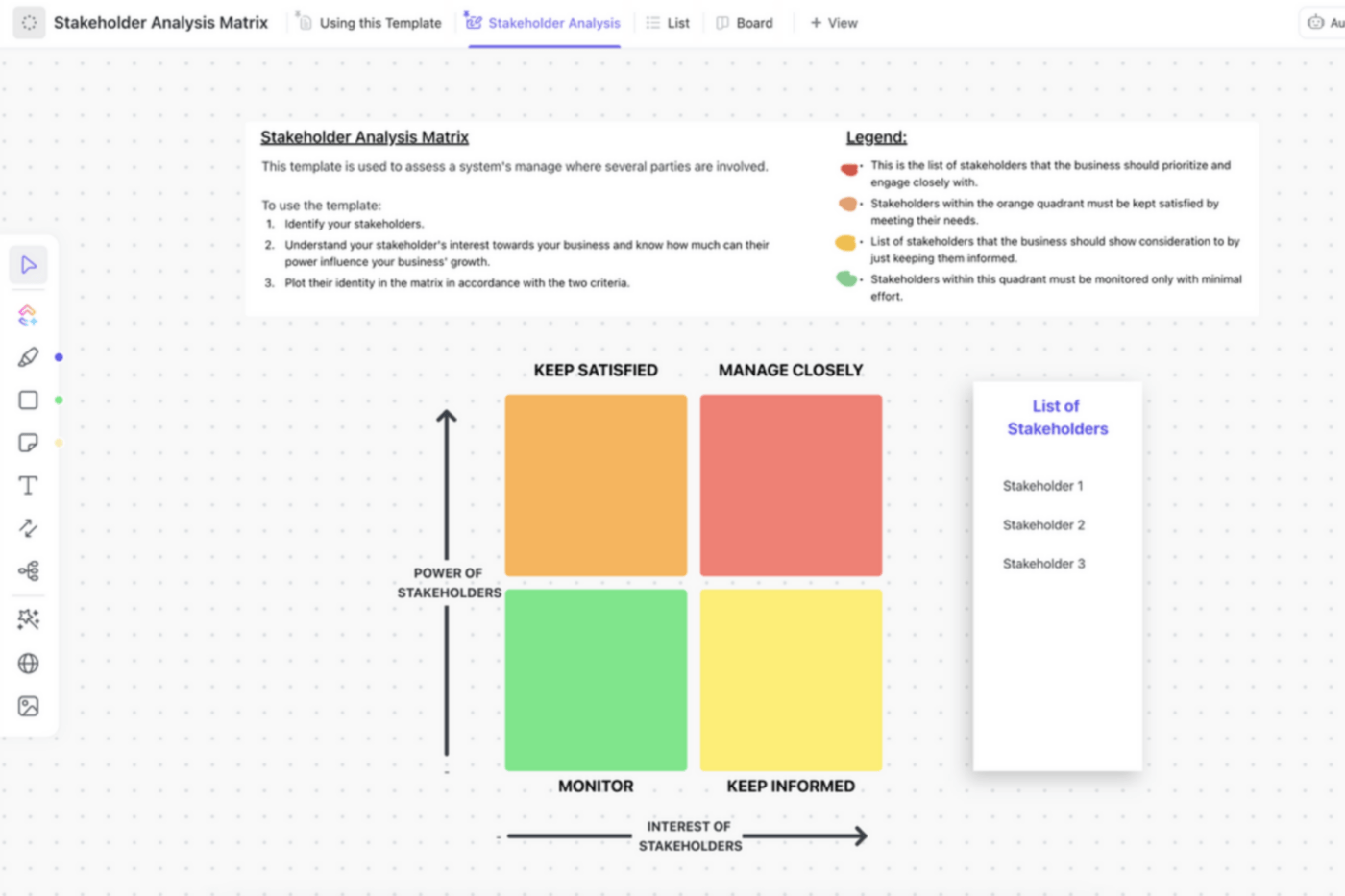Implementing Stakeholder Theory: Strategies for Business Success

Sorry, there were no results found for “”
Sorry, there were no results found for “”
Sorry, there were no results found for “”
Why should a corporation exist? What is its purpose in society? Economists, sociologists, and others have tried to answer this question since time immemorial.
Merrick Dodd, a Harvard law professor, suggested in the 1930s that businesses had at least four stakeholders: shareholders, employees, customers, and the general public. What Dodd proposed challenged the traditional view that corporations must serve only shareholders, i.e., pursue profits and growth alone.
The theory has since become one of the more influential management frameworks, impacting corporate ethics, social responsibility, and business operations.
In this blog post, we’ll explore stakeholder theory as a framework for business success.
The stakeholder theory proposes that entities directly affected by or affecting a company must be considered in determining its long-term health. These might be internal stakeholders, such as employees or owners, or external stakeholders, such as suppliers, creditors, customers, and the government.
Developed formally in 1984 by economist Edward Freeman, the stakeholder theory counters the more popular shareholder theory.
It argues that an organization’s success is intricately tied to ensuring every stakeholder in the profit cycle is treated well and becomes a beneficiary of a company’s success.

Management is filled with theories and frameworks that define how organizations conduct business. To clearly understand stakeholder theory, you need to know how it’s similar or different from other related theories. Let’s see a few.
Stakeholder theory emphasizes an all-for-one approach. It suggests that businesses consider the interests of employees, customers, creditors, suppliers, and the community, in addition to the shareholders.
A stakeholder theory example might involve a company that prioritizes:
Shareholder value focuses on maximizing profits for the company’s shareholders alone, which may or may not be at the expense of the other stakeholders. This one-for-all approach puts shareholders at the center of a company’s success and makes them the prime owners of its profit.
A company prioritizing shareholder value might:
Stakeholder theory frames the corporation as part of a network of various entities that impact the business.
On the other hand, agency theory assumes a principal-agent relationship, where shareholders are the principal and company executives/business leaders are the agents.
Here, the focus is on the relationship between the principal and agent, on maximizing shareholder wealth and aligning actions with shareholder interests.
Like the shareholder value model, the agency theory is also shareholder-centric and accountable to them as the principal stakeholders.
“The social responsibility of business is to increase its profits,” wrote economist Milton Friedman, setting out the Friedman doctrine, also known as the shareholder theory.
Stakeholder theory says that all corporations have a moral obligation of social responsibility as it impacts stakeholders, such as the community and the immediate environment.
On the other hand, Friedman’s doctrine asserts that a company’s sole responsibility and loyalty is towards its shareholders. If any social responsibility is expected out of the corporation, that can only come from directives approved by its shareholders.
For instance, KPMG finds that “If a company performs well in ESG and avoids an ESG liability (e.g. impairment), it can expect to drive positive shareholder value.”
Therefore, shareholders will approve socially responsible projects/changes for their own gain.
As you can see from the differences above, much of business management philosophy revolves around increasing shareholder value. The stakeholder theory provides an alternative, enabling value addition to everyone in the ecosystem. Let’s see how this impacts strategic management.
Stakeholder theory broadens an organization’s vision. It guides a corporation in designing processes and taking action that serve the needs of all groups with a stake in the business.
If you’re using stakeholder theory as part of your strategic management, you would think about your business in the following ways.
Focus: Emphasizing the network of systems and individuals connected to a business and creating collective value.
For example, instead of optimizing locally to reduce transportation costs, you will optimize globally to improve logistics efficiency without affecting any individual supplier.
Success: Ensuring that a corporation’s success has a net positive impact on people, community, and society. This would involve making moral and ethical decisions about using natural resources, labor practices, etc.
Metrics: Broadening the scope of performance to metrics beyond financial ones and including important outcomes for other stakeholders. Instead of just profit or ARR as the primary metric, you might also include employee satisfaction or community contribution.
Ethics: Integrating ethics and efficacy in decision-making instead of just focusing on efficiency or cost savings. You might emphasize on inclusive practices in hiring or insist on pay parity.
With the philosophy well understood, let’s apply stakeholder theory in practice.
Identify > align > engage: The simple three-step process to implementing stakeholder theory within your organization with the help of a robust project management software and purpose-designed stakeholder mapping templates.
To begin with, identify who the stakeholders are. Stakeholder analysis identifies internal and external groups that may impact your organization in one way or another.
If you’re leading software development at your organization, your project stakeholders would be developers, quality analysts, business analysts, customers/project sponsors, users, etc. If you’re an energy company, environmental groups might be critical in addition to the above.
ClickUp Mind Maps or Whiteboards can help the team come together and ideate on the various stakeholders. The ClickUp Stakeholder Map Template is a great starting point.

Once you know who the stakeholders are, it’s time to understand their needs, demands, and interests, and align with them.
Build relationships: Reach out to each stakeholder and understand their core values. Visualize all the ways in which the organization impacts or is impacted by the organization.
For example, a developer in a software team might be playing a role in the quality and timely delivery of the product. On the other hand, the organization contributes to the employee’s financial and mental well-being. This relationship needs to be understood and mapped.
Bonus: Here are a few core values examples to get you started on this journey.
Track the roster: A business or project is expected to have dozens of stakeholders. Keep track of all these stakeholders and their contact information in one place. Conduct extended stakeholder analysis to understand their interests across various parameters.
ClickUp CRM is the perfect stakeholder management software for this use case. Use the SOAR analysis framework to understand all stakeholder groups in detail.
Strategize: Stakeholder management balances competing priorities and develops a strategy that maximizes value for every key player.
Create a ClickUp list or board with detailed profiles of each stakeholder. Outline what maximizes value for each of them. For instance, employees might need more work-life balance, while the community needs fewer pollutants.
Use the fully customizable ClickUp Stakeholder List Template to visualize stakeholder needs.

Give every stakeholder visibility into what matters to them. Communicate consistently and give updates.
The ClickUp Dashboard is a fantastic way to do this. With customizable widgets, you can help them track value and encourage more profound stakeholder engagement.
You can also plan your communications with the Stakeholder Analysis Matrix Template. Depending on the power and interest of each stakeholder, decide whether to monitor, manage, keep informed, or keep satisfied.

Stakeholder theory is primarily a framework for making business decisions. Yet, it has more impact on a few specific areas than others. Let’s discuss applying stakeholder theory in these cases.
Corporate Social Responsibility: CSR focuses on the environment and community stakeholder groups. For example, considering the community as your stakeholder, you might use this theory in CSR to:
Business ethics: What’s the right thing to do? Shareholder theory suggests that anything that maximizes shareholder value is right.
Stakeholder theory contests that. It emphasizes that companies must create value for all parties involved in the organization, not just shareholders. By using stakeholder theory in making ethical decisions, you will:
Competition law: All forms of competition regulation aim to maintain competition by regulating anti-competitive conduct, restrictive trade agreements, behavior like price gouging or predatory pricing, and mergers and acquisitions.
Stakeholder theory’s influence on competition law means increased transparency, accountability, and a landscape that benefits the market as a whole.
Stakeholder theory fundamentally shapes a company’s business value proposition. It helps design and communicate an organization’s place in the marketplace from the collective perspective of all stakeholders.
For example, the tech giant, Apple positions itself on strengths of security, which is fundamental to its customer base. Several of the world’s largest companies move towards the ‘sustainability’ positioning with pressure from governments and customers.
This positioning is not just marketing-speak. It drives on-ground action, forcing businesses to walk their talk. It leads to the company’s business roundtable, reinforcing commitment to all stakeholders, including customers, employees, communities, and shareholders.
If that sounds like a perfect framework for business decision-making, you might want to exercise a little caution. Here’s why.
Stakeholder theory, while popular and preferred over the more narrow shareholder theory, is not without its criticisms. The most common ones include the following:
Who is a stakeholder? There is a lack of clear definition of who constitutes a stakeholder and what their relation to other stakeholders and to the corporation itself should be.
Who matters how much? Multiple narratives and discourses have the potential to muddle discussion and create narratives that have no connection to the principals.
Whose interests influence decisions? Prioritization of stakeholders amidst a diverse and high number of stakeholders can often lead to dilution of issues and decision paralysis that can harm the business.
Who is the principal and who is the agent? Conflict between priorities of the principal (owner or shareholder) and the actions of the agent (company executives). of the asset don’t align, also known as the principal-agent problem.
Who has the incentive? Incentives, financial or otherwise, can impact stakeholder behaviors and their contributions. Would a shareholder support a decision because they get the incentive of additional returns? Would employees be less productive because it is in their interest?
How to manage the politics? Stakeholders in any system have three attributes: Power, legitimacy and urgency. For instance, customers can reject a product, having great power in influencing what gets created. On the other hand, a vendor or a supplier might not be as legitimate a stakeholder as a customer is.
Considering how complex these relationships are, stakeholder theory might be much more appealing in theory than in practice.
So, what’s next?
Stakeholder theory creates a sub-sector of models around governance, externalities, and incentives to help guide corporations toward long-term success.
Emerging stakeholders: In the social media era, the definition of a stakeholder (and their legitimacy and influence) is expanding. A customer can complain on Twitter. An influencer can give you a bad review on YouTube.
Today’s businesses need to adapt to a diverse and inclusive stakeholder management function.
Collective conscience: Businesses can not ignore the social responsibility of their work. Several big brands have been rejected for inappropriate advertising, and others have had to retrack their ads.
You need to develop a deeper cultural understanding of your stakeholders.
Profit vs. the right thing (or not): The debate about profit or responsibility is no longer relevant. Today, profit comes from responsibility. New-age direct-to-consumer (D2C) sustainable products are gaining market share over traditional brands.
New metrics: Even shareholders today look for indicators such as impact on environment, employee satisfaction, community relations, CSR impact and more.
You need to think beyond financial metrics and find ways to measure the qualitative impact.
Happiness: For any business to consider ‘happiness’ as a factor involves taking a more humanistic approach to work. This means transforming human resource management to support employees to do their best work and live their best lives.
Whether embracing stakeholder theory in the present or expanding it into the future, we’ve got the right toolkit for you.
Let’s circle back: Why should a corporation exist? What is its purpose in society?
Stakeholder theory suggests that a corporation exists to balance and serve the needs of all stakeholders, including but not limited to shareholders, employees, customers, vendors, neighborhoods, community, environment, and more.
It impacts value creation, ethics, and managerial mindset, ultimately enhancing organizational decision-making processes.
It emphasizes identifying and profiling all stakeholders, regularly collecting feedback, creating diversity frameworks, embracing technology, and more.
ClickUp’s all-in-one platform for business operations is designed to enable all this and more. Manage all your stakeholders in one place and keep them all informed in real time.
Get started for free. Try ClickUp today.
© 2026 ClickUp